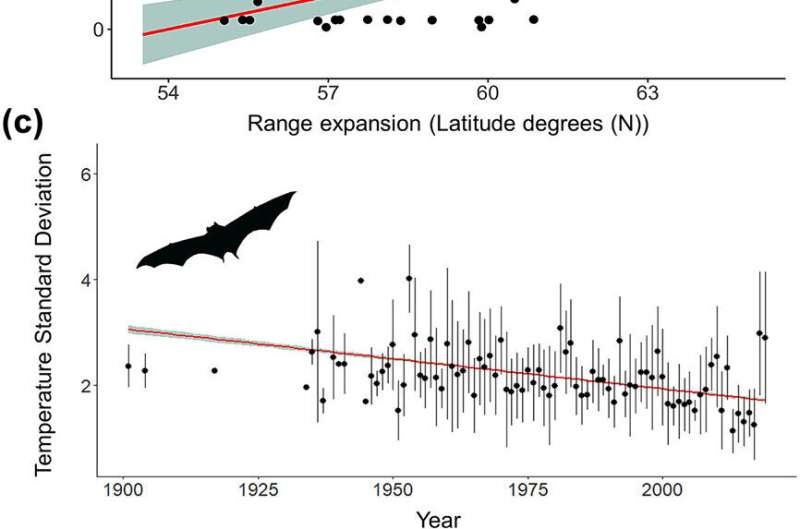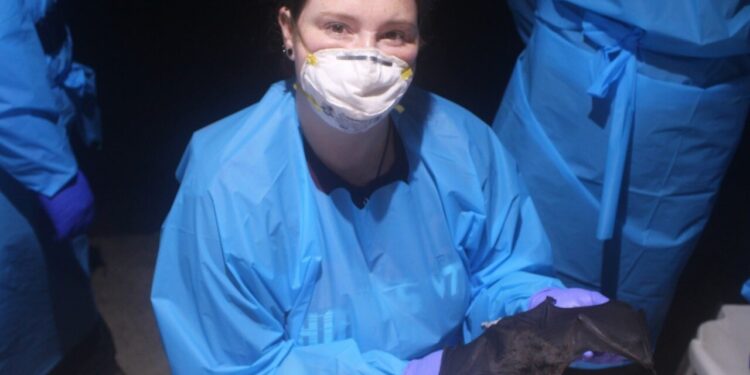Paige Van de Vuurst, a Ph.D. student in translational biology, medicine and health, is conducting field research on vampire bats in Colombia this summer. Credit: Paige Van de Vuurst
Vampire bats could soon move into the United States and bring an ancient pathogen with them. “What we found is that the distribution of vampire bats has shifted northward over time due to past climate change, consistent with an increase in rabies cases in many countries from Latin America,” said Paige Van de Vuurst, a Ph.D. student in the Translational Biology, Medicine and Health graduate program at Virginia Tech.
Van de Vuurst is the lead author of research recently published in Ultrasound This predicts that vampire bats – currently only found in Mexico and Central and South America – are on the move, with the United States becoming a viable home in 27 years. The results concluded that with the change in seasonality (the temperature differences between colder and warmer seasons), vampire bats have expanded their locations in search of more stable and temperate climates.
The research team, which included undergraduate and graduate students, also found that this expanded reach could be linked to a spread of rabies. Vampire bats are known to carry rabies, a disease known for its high mortality rates and often considered the oldest pathogen known to man, dating back 3,000 years.
Latin America is currently feeling the bite of rabies spreading through loss of livestock, sparking fear as bat migration patterns expand. The Virginia Tech team aims to vigorously identify and track the bats by traveling to Colombia to help contain the spread to other countries, including the United States and its vital cattle industry.
Why Colombia?
“Colombia is a very diverse country, which makes it a perfect natural laboratory,” said Luis Escobar, assistant professor in the Department of Fish and Wildlife Conservation in the College of Natural Resources and Environment. The country boasts the highest number of hummingbirds and bats, attributed to its tropical climate and proximity to the equator.
In collaboration with three local universities (Universidad de La Salle, Universidad Distrital, and Universidad del Tolima), the collective team traveled throughout Colombia to collect more than 70 samples of bat species. This included a series of geographic and climatic changes, from hot, humid jungles to cold, cloudy parts of the Andes that are only accessible by cable car. This allowed the team to obtain a variety of samples and observe how climate change may alter disease emergence in bats.
The team also explored places in Colombia that were previously closed to scientists, including Chaparral, a municipality in the Tolima region that was allowed to start welcoming tourists after the 2016 peace agreement.
The team’s research aimed to fill a knowledge gap that limits understanding of the spread of rabies and its impact from wildlife to humans. Their work had three main objectives:
- Determining the role of habitat and virus mutation on the spread of rabies to humans and livestock in Latin America
- Identify the effect of changes in biodiversity on the spread of the rabies virus
- Study the geographic and environmental factors that influence the spread of bat-borne diseases

Outbreaks of bat-borne rabies are increasing in Latin America. (a) Percentage change in rabies outbreaks in cattle in Latin American countries between the 1970s and 2010. (b) Regression relationship between northern range expansion of Desmodus rotundus and outbreaks rage in Latin America (1970-2019). (Slope = 86.61, R2= 0.36, p < 0.001.) (c) Reduction in temperature seasonality in D. rotundus capture sites over time. (Slope = −0.01, R2= 0.07, p < 0.001.) Black dots and lines: distribution of temperature standard deviations of all D. rotundus occurrence sites for each corresponding year. Credit: Ultrasound (2023). DOI: 10.1111/ecog.06714
Immerse yourself in the experience
This field experience allowed four undergraduate students and two graduate students to travel to Colombia. Van de Vuurst led the team’s campus-wide recruiting efforts, resulting in 30 interested students from across disciplines.
Before the trip to Colombia to study vampire bats, Escobar and his team gathered near Duck Pond to review critical safety information and field sampling protocols.
“We have selected a truly remarkable group of students and I couldn’t be more proud of them,” Van de Vuurst said.
She had the opportunity, while she was a student, to take an international excursion to Peru. “This trip changed my life and truly opened up the world of ecology for me. I’m so happy that we were able to provide the same kind of unique research experience to so many students through hard work and dedication. generosity of Luis.”
For undergraduate Julia Alexander, it was a series of firsts, including a first time in the field, a first time on a plane and a first time outside the country.
As a member of the Escobar lab research team, Alexander was able to study disease transmission in vampire bats and other local bat species, working with local communities in the Tolima region . It was extremely important for Escobar and Van de Vuurst to be able to offer an international research opportunity, knowing that undergraduate students are not usually able to participate in such an experience.
“Not only have I learned valuable field skills for my career, but I have also learned important life lessons through each challenge I encountered,” Alexander said. “Even though this journey hasn’t been easy, I wouldn’t trade this experience for anything else.”
Crossing borders to collaborate
The value of building an international collaborative network cannot be understated, particularly in terms of commonalities in technology, facilities and students between Virginia Tech and its international partners.
In fact, Escobar welcomes Diego Soler-Tovar, assistant professor from La Salle University, who will work in Escobar’s laboratory until the end of January 2024, to study the factors in the spread of rabies in Latin America.
“We all have one goal: to generate samples, new data and new knowledge,” Escobar said.
More information:
Paige Van de Vuurst et al, Climate change linked to the expansion of vampire bats and the spread of the rabies virus, Ultrasound (2023). DOI: 10.1111/ecog.06714
Provided by Virginia Tech
Quote: Research links climate change to expansion of vampire bats and spread of rabies virus (November 27, 2023) retrieved November 27, 2023 from
This document is subject to copyright. Except for fair use for private study or research purposes, no part may be reproduced without written permission. The content is provided for information only.



